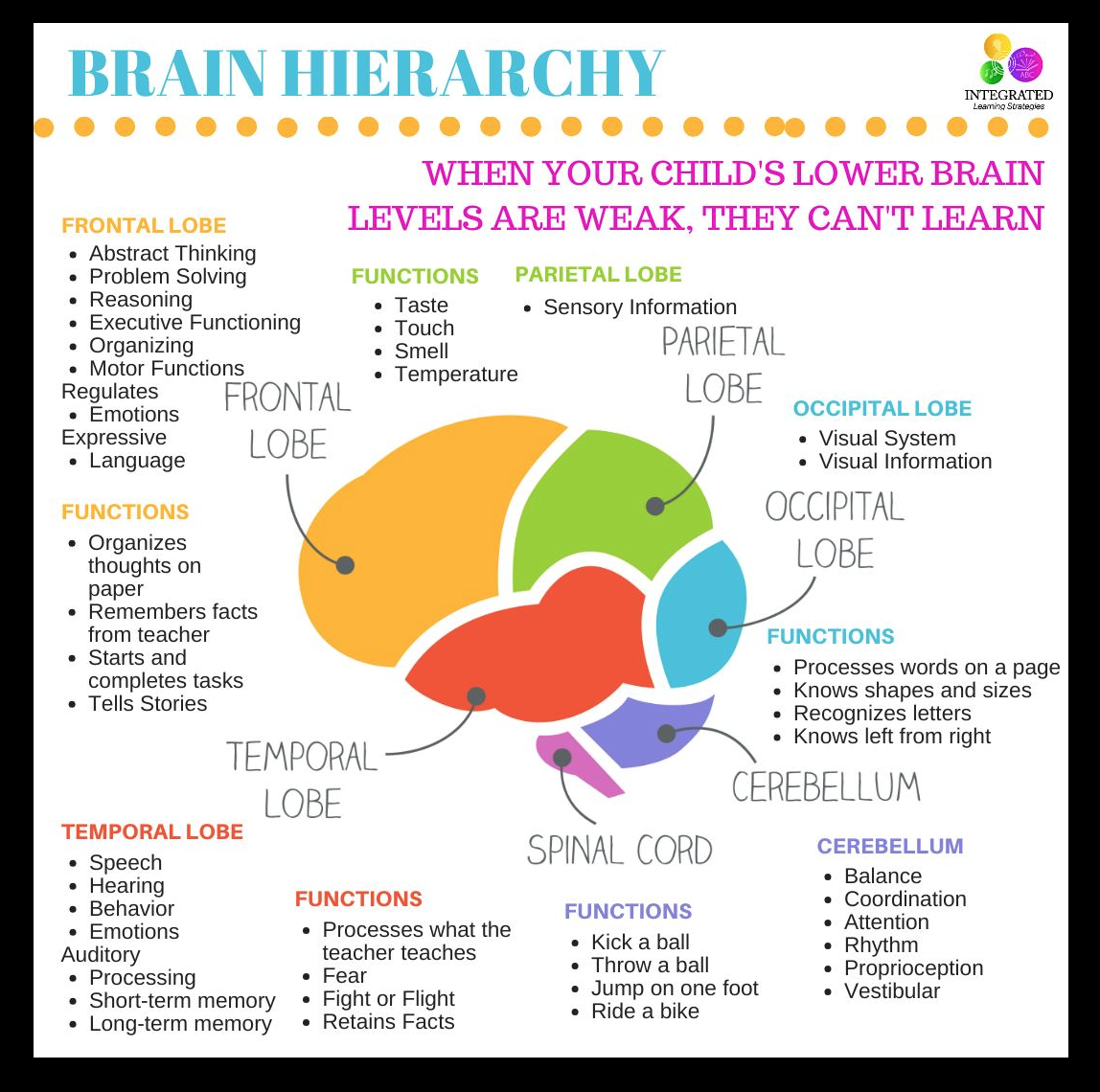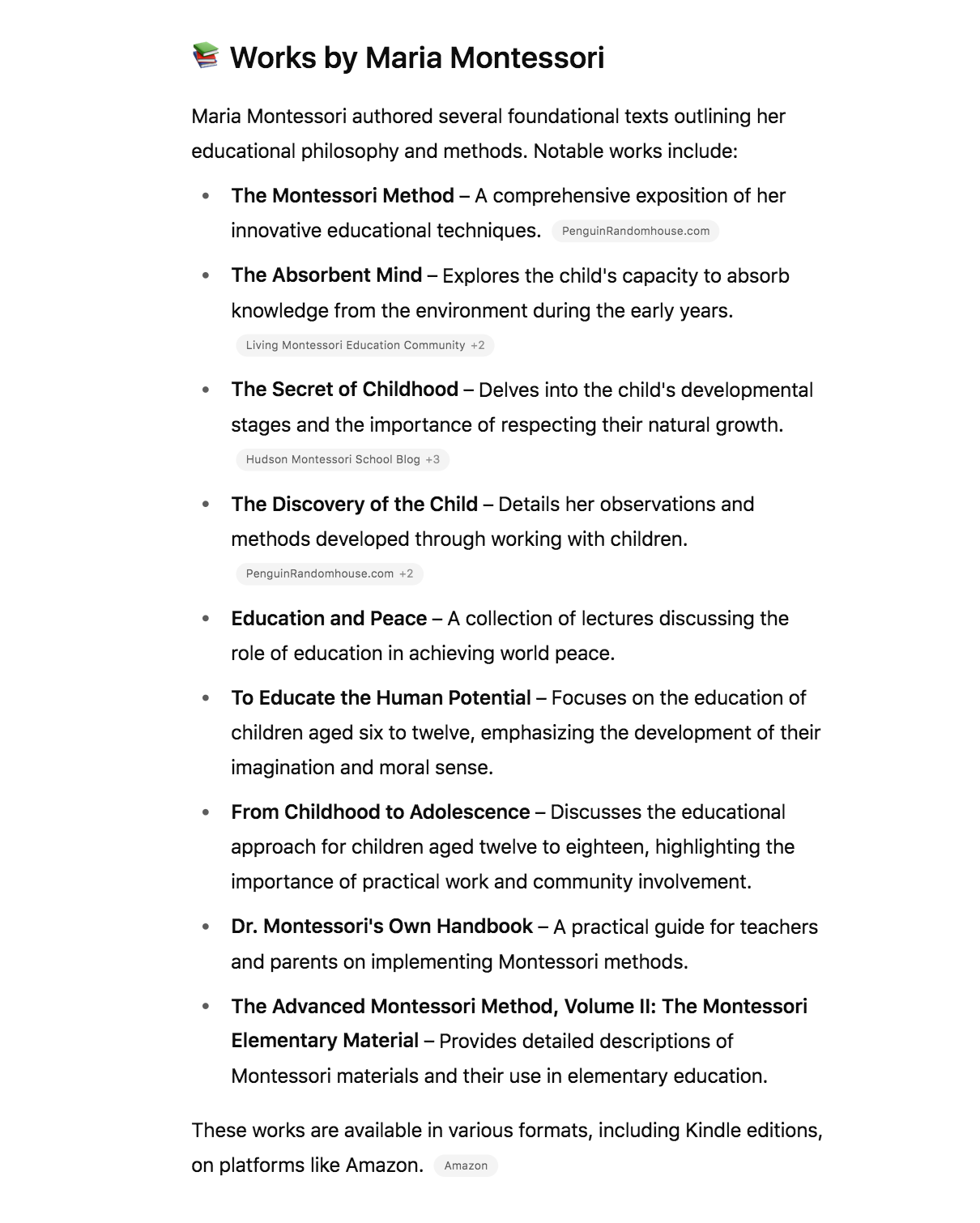The Trivium
The Trivium: Grammar, Logic, and Rhetoric: The Liberal Arts, and the Mortensen & Montessori Methods.
The Trivium, The Trifecta of the classical liberal arts, consists of grammar, logic, and rhetoric.
The
word trivium comes from Latin, composed of two parts: tri- meaning
"three" & via meaning "road" or "way" So,
trivium literally means "the three way or the three fold
path”. Think of it as a road with three lanes that takes you through the journey that leads to self education, and eventually self actualization through cultivating the ability to think creatively and logically. Cultivating the ability of learning how to learn and at first what to learn, but eventually when you know how to learn you choose what you want to learn, you learn how to think, not what to think. What you think should be up to you but i assure you there are those who would do your thinking for you if you but let them--always to your detriment.
The
Trivium has been the cornerstone of intellectual thought in the
Western world since the age of enlightenment, the Renaissance, on
through the founding of the American Republic's Education System. Our
“Founding Fathers” were well aware of the Trivium and well
educated in the liberal arts. Since then sinister forces have
infiltrated the education system of the United States corporation and
the Trivium was all but “forgotten” in public education, replaced
with ridiculous and ineffectual methodologies that have proven to do
more harm than good. Meanwhile, the more the Trivium is scrutinized
the more the Trivium is confirmed by science as a useful and
effective pedagogical artifice, a teaching framework, that can be
applied to modern thought and is as useful & efficacious in “the
modern era” as it ever was in classical times or “ancient”
times. Learning how to learn and how to think will never go out of
style, lack relevance, or become passé.
From ancient Greece
through the medieval university system, these three disciplines were
not merely academic subjects, but well known progressive stages of
learning that shaped how educated men and women understood,
processed, and communicated knowledge among each other. It is an
effective foundational framework for instruction no matter the
subject.
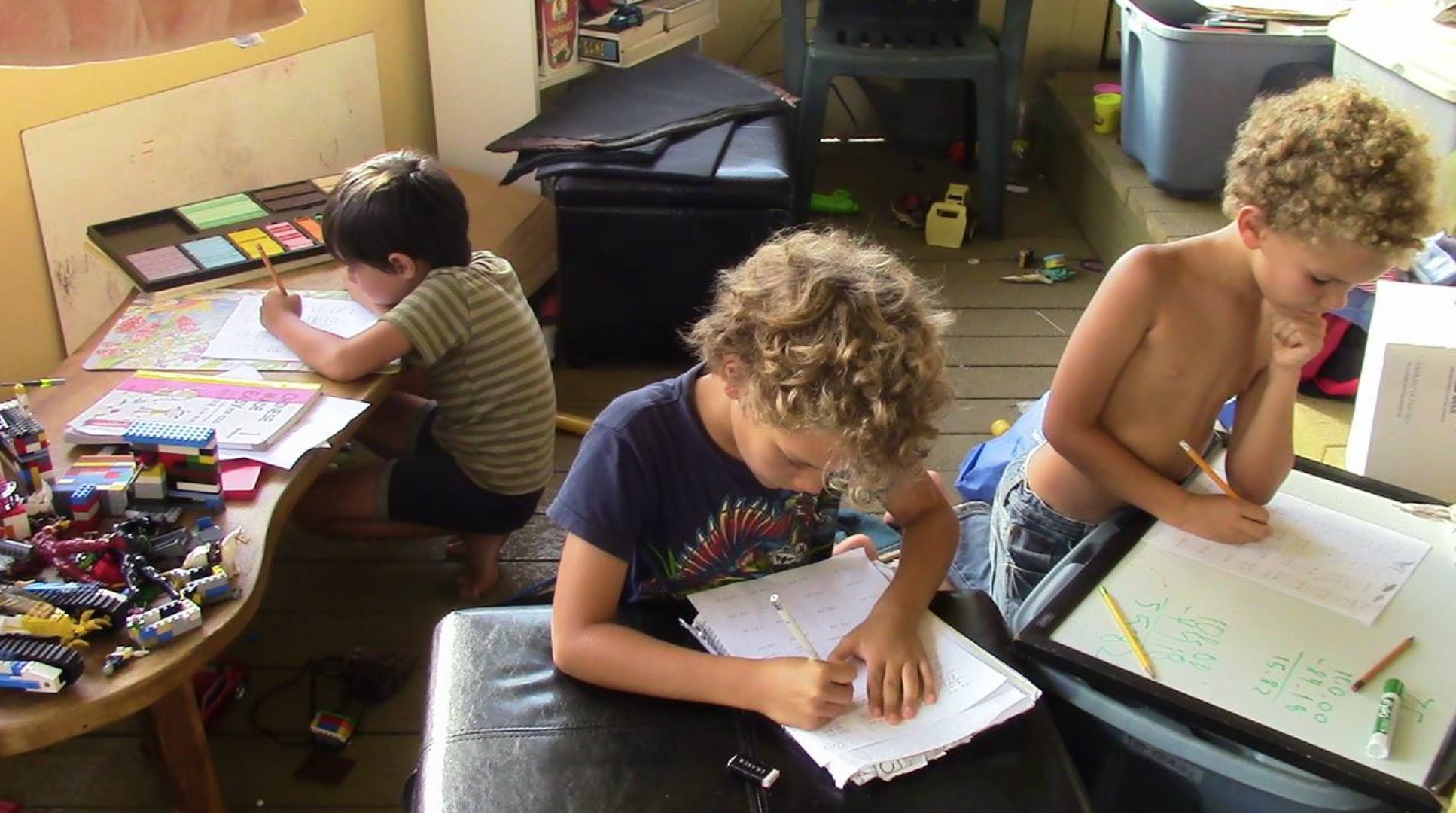
Crewton Ramone's House of Math is restoring the use
of the trivium to organize thought and educate the masses. Here, i
show you some of it's application in teaching and, of course, homeschooling. This applies to all subjects, not just mathematics. The same way the three period lesson is used to introduce any concept or manipulative.
The Trivium,
the classical threefold path of education—grammar,
logic, and rhetoric—has
guided "upper class" learners for centuries. More than just a subset set of the seven
subjects that make up the liberal arts, it is the foundation that leads to a developmental journey
of learning how to learn and how to think. It aligns naturally with
the liberal
arts tradition on
University Campuses because it is the foundation of the liberal arts.
It
is
embedded within the Montessori
method,
and reveals deep inter connections with mathematics
and the other philosophies, arts and sciences.
But beyond these obvious academic applications, the Trivium also aligns with
neurological
development, specifically with stages of human brainwave activity
but also can be applied to the science of epigenetics..
When viewed through this lens, it becomes clear that the Trivium
isn’t just educational theory; it is a blueprint for human
cognitive growth and development that worked effectively for ages and
the US Federal Department Of Education has strayed FAR from these
fundamental and foundational principles and pathways, some would say
on purpose. Rather than going tangetal on that topic, some of the work of John Taylor Gatto is presented here as well as Charlotte Iserbyt.
“I've noticed a fascinating phenomenon in my thirty years of teaching: schools and schooling are increasingly irrelevant to the great enterprises of the planet. No one believes anymore that scientists are trained in science classes or politicians in civics classes or poets in English classes. The truth is that schools don't really teach anything except how to obey orders. This is a great mystery to me because thousands of humane, caring people work in schools as teachers and aides and administrators, but the abstract logic of the institution overwhelms their individual contributions. Although teachers to care and do work very, very hard, the institution is psychopathic -- it has no conscience. It rings a bell and the young man in the middle of writing a poem must close his notebook and move to a different cell where he must memorize that humans and monkeys derive from a common ancestor". ~John Taylor Gatto.
The Trivium: Effective Methodology
Long before modern education systems emerged, the
Trivium was a time tested, functional methodology of which Maria was
most certainly aware, she was classically educated. Today, the
enduring value of the Trivium resonates through liberal arts
education, Montessori methodology, and of course: the realm of
“Mortensen Mathematics” as purveyed by Crewton Ramone's House of
Math and The Temple of Math: The Mathedist Church.—each
interpreting the Trivium not as a discarded relic, but as a living,
breathing, useful pedagogical structure that should be understood and
used to give structure to any modern learning environment, whether it
be a Montessori Classroom, or a homeschool, or a university lecture hall.
“Free
the child’s potential, and you will transform him into the world.”
~Maria
Montessori
Maria Montessori: Education, Influences, and the Trivium.
Maria Montessori
(1870–1952), Italy’s first female physician, transformed
education by grounding it in scientific observation and respect for the child's natural development. Her medical training at the University of Rome
led her to study and earn degrees in anthropology, psychology, and pedagogy, giving her a
holistic view of human growth. Montessori deeply valued the
Trivium—grammar,
logic, and rhetoric—as
a developmental framework.
Dr. Montessori's Own Handbook:
Dr. Montessori's Own Handbook was first published by Frederick A. Stokes Company in 1914 in the United States.
i highly recommend you buy hard copy or print this so you can highlight and underline and add notes.

The book is a practical companion to Dr. Maria Montessori's earlier theoretical works and was intended to help teachers and parents understand and apply the Montessori Method in practice. Crewton Ramone's House of Math gives you both theory based on Maria practices. The Mortensen Method is just the Montessori Method applied to math with added socratic method and FUN. The Montessori Method is just the classical method applied to education. The "Mortensen Method" is the classical method applied to Arithmetic specifically through the Lens of Maria and Mario Montessori.
Purchase this book and read it...take notes. Mark it up. Underline. Your homeschool or classroom will be better for it. You're welcome.
When they are very young trigonometry is just vocabulary in the grammar stage. Sin means opposite over hypotenuse. Tan means opposite over adjacent depending on where the man is standing. Any eight year old easily understands that. i can hand them the triangle. they can examine it with their hands. They understand cos is the inverse of sin. They can hold it and look at it and see how the symbols relate and describe the triangle. When we introduce cosin, cosec, and cotangent the inverse is also easily understood.
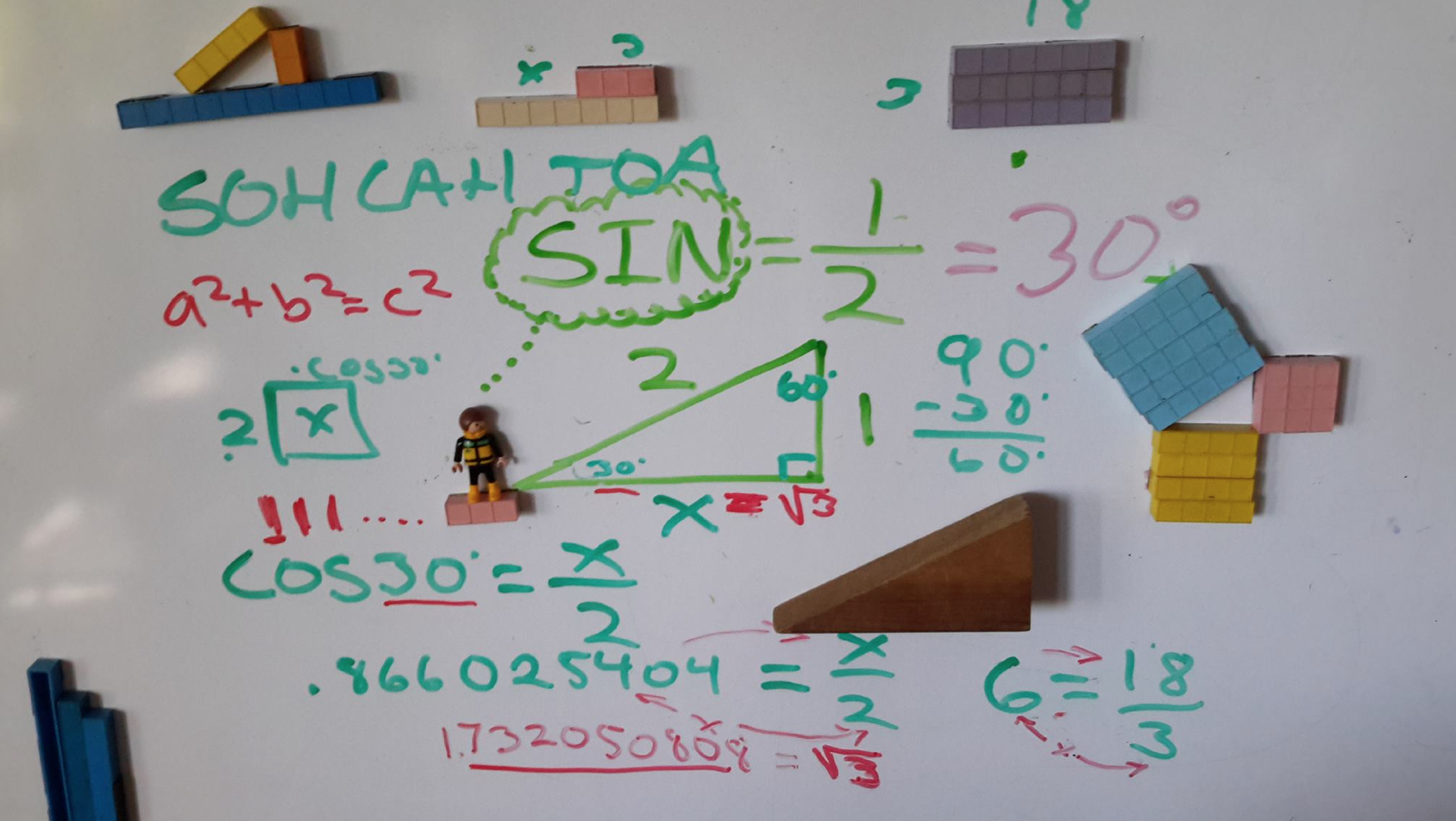 In a math rich environment, the child learns math. You create the environment. Base ten blocks, white board pens...perhaps give a task. Build something cool so i can take a picture of it. Walk away.
In a math rich environment, the child learns math. You create the environment. Base ten blocks, white board pens...perhaps give a task. Build something cool so i can take a picture of it. Walk away.Maria aligned the Trivium's stages with her own educational method: early language and symbol acquisition (grammar), reasoning and exploration (logic), and expressive, purposeful communication (rhetoric). Jerry aligned his method with hers but many of Jerry's students, copycats, and trainers have strayed far from this framework. i, myself have been lax in it's formal presentation until now; however, if you were familiar with classical education and Maria's Methodology it should have been abundantly clear what i was doing in my trainings and where i get my teaching and presenting style. Here i hit you over the head with it as it were. Now you see why i emphasize learning multiplication tables EARLY. You make it fun. Singing. Playing. Dancing. Not work sheeting.
Her approach was
shaped by work with disabled and disadvantaged children, where she
observed that intellectual growth occurs best through hands-on
learning, independence, and freedom within structure. i found the same to be true in the field not just from reading her work. Some of that is recorded here on this website. Visit Sarah's page for one. Emma's page for another. Montessori’s
philosophy resonated with classical education, but her implementation
was modern, intuitive, and deeply humane. i have stress tested the method in classrooms, homeschools, lecture halls, and everywhere in between. i have proven the method works but i have also spent quite a bit of time figuring out why it works. For that i had to study the brain and mind. Adding the kinesthetic component is key. Jerry also figured out you could use the same set of materials to teach counting through calculus. And his materials were basically all you needed to create a math rich environment.
"The
child is endowed with unknown powers which can guide us to a radiant
future. If what we really want is a new world, then education must
take as its aim the development of these hidden possibilities."
~Maria Montessori, Education
and Peace
(1949)
100%.
Thus
Crewton Ramone's work with “disabled and disadvantaged children”
particularly with the autistic, wherein i proved repeatedly that this
methodology ABSOLUTELY works. When Crewton Ramone teaches the entire
class, 100%, achieve mastery...everybody gets and A not because of
DEI or grading on a curve but because once they understand concepts
getting perfect scores is natural. My elder son scored 100% on the
the GED Math Practice Test for the State of Hawaii. Perfect scores so common, i usually didn't document the many, many members of the 100% club. The same way my website covers a fraction of the students i have worked with over the years. But there is more than enough here to make you what will be considered an extra-ordinary teacher. Especially when you are teaching algebra to four year olds as a matter of course.
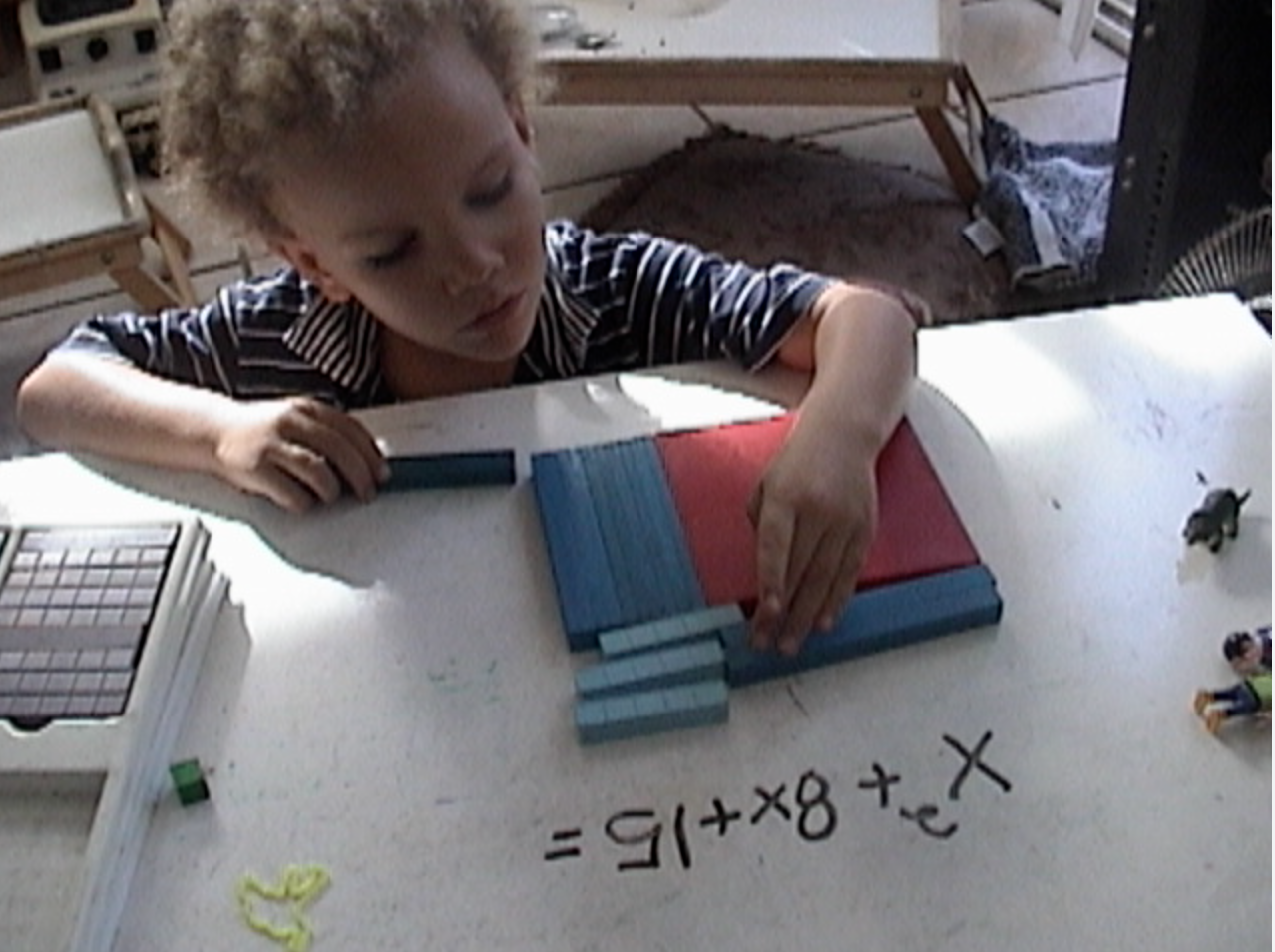 Every child likes a good puzzle. Vertical alignment, here we are much more interested in 3 + 5 and 3 x 5 than we are with algebra or solving for x or graphing it. All that comes later. By degrees.
Every child likes a good puzzle. Vertical alignment, here we are much more interested in 3 + 5 and 3 x 5 than we are with algebra or solving for x or graphing it. All that comes later. By degrees.People think i am a gifted teacher. A math genius. i failed calculus. Had i passed easily you wouldn't be reading this and there would be no website. i have excellent tools and an excellent methodology. i was taught how to apply and implement the methodology. The beauty of it is i can teach it to anyone who wants to learn. And i have. There are more than a few people who used to make or are making a very decent living teaching math with base ten blocks who i am responsible for getting started. i say used to make because many have since passed on, demand is unceasing though.

Logic and Reasoning 101
If
the method works on “disabled and disadvantaged children” how
much better is it on “normal” children? Best of all, it is great with genius or
gifted and talented children, better than great. The Mortensen Methodology is not a
remedial methodology although it is perfectly suited for that
application, it is effectively super learning or accelerated learning.
Best of all, it really is FUN because it makes math simple and visually obvious.
Don't
tell me this method doesn't work. i have had stellar success with
Autistic students. Name the disability, i've worked with them. Blind,
deaf, crippled, quadriplegic, paraplegic, ADD, ADHD, “F”-Troop
bottom of the class, FootBall players who couldn't play without a
“C” in algebra getting “A's” instead. Maria's influence on
me was partly due to and because of others' influence on her. We all
stand on the shoulders of giants. The idea is to make people
understand WHY it works so well. “Like magic”.
The magic is the tactile component.
Maria Montessori,
though most famous for her innovations in early childhood education,
was classically trained and well-versed in the liberal arts. She
explicitly connected education to stages of mental development and
emphasized that learning should begin with naming
and order,
followed by reasoning,
and culminating in self-expression—the
very sequence of the Trivium. She added the kinesthetic component often through play.
Discipline is a gift.
Maria Montessori graduated from
the University
of Rome in 1896,
earning her degree in medicine. The Liberal Arts and the Trivium were alive and well at the University of Rome in 1896. In fact, i would expect the philosophy was taken for granted at the University of Rome at that time. She was the first
modern woman in Italy
to receive a medical degree, a groundbreaking and controversial achievement at the
time. Her studies and early work in psychiatry, anthropology, and
education at the university laid the foundation for her later
development of the Montessori Method. Her study of pedagogy would have included the Trivium and the Quadrivium, at the University of Rome. In 1896.
She expected you to know and recognize her Method's use of the classical model, the same way she would expect you to know what kind of eggs to use in a common recipe...you know to use chicken eggs, not duck, or ostrich. The Mortensen Method is based on the Montessori Method which is based on the classical method. Jerry could have explained this to you himself except he died and stubbornly refused to write very much down. His portion of the mathematics is after all, an oral tradition.
To be clear, my pedigree is direct. Crewton Ramone -> Vernon J. Mortensen -> Mario Montessori -> Maria Montessori. Words spoken to Jerry by Mario were spoken to me by Jerry. Some of those words have found their way to this website and my blog. Some of those words were spoken to Mario by Maria. They have been translated into English and passed through time to get here. Let us focus on what has been preserved, not on what has been lost in translation.
Brief Synopsis of
Maria Montessori’s
Influences
"Helen Keller and Mrs. Anne Sullivan Macy, who are, by their example, both teachers to myself––and, before the world, living documents of the miracle in education". Watch the movies when you have the time.
Jean-Marc-Gaspard
Itard
(1774–1838): A French physician known for his work with the "wild
boy of Aveyron," Itard pioneered individualized education and
believed sensory training could civilize and educate even children
with severe disabilities. Adding the sense of touch, the kinesthetic
tactile component is crucial and the foundation and beginning cornerstone of most three period lessons where we start in the concrete.
Édouard
Séguin
(1812–1880): A student of Itard, Séguin emphasized physical and
sensory exercises to help intellectually disabled children. He
developed tools and methods for structured, sequential
learning—directly influencing Montessori’s materials. Jerry
improved on these materials. He took her materials and took them
further, making manipulatives that were versatile (the combo kit) and
could be used throughout the progression from counting through
calculus. And from the Trivium (grammar, logic, rhetoric) which
trained the mind in language and thinking, Jerry moved on to the
Quadrivium with the focus is on Arithmetic and Mathematics particularly
Algebra but also music and Chemistry.

Friedrich Froebel (1782–1852): The German founder of the kindergarten movement, Froebel believed in play, creativity, and nature as essential to early learning. His “gifts” (manipulatives) and focus on child-led discovery laid groundwork for Montessori’s prepared environment. His idea was a place, a yard, an area for little ones full of educational materials and manipulatives and a playground full of play equipment. The ancestor of the math rich environment spoken about by Crewton Ramone and Jerry Mortensen.
“The environment must be rich in motives which lend interest to activity and invite the child to conduct his own experiences.” ~ Maria Montessori, The Discovery of the Child (1948)
Her description
of the “absorbent
mind”
(grammar stage), the “reasoning
mind”
(logic stage), and the “valorization
of the personality”
(rhetoric stage) align precisely with both the Trivium and contemporary
neurological research.
The Trivium and the Liberal Arts
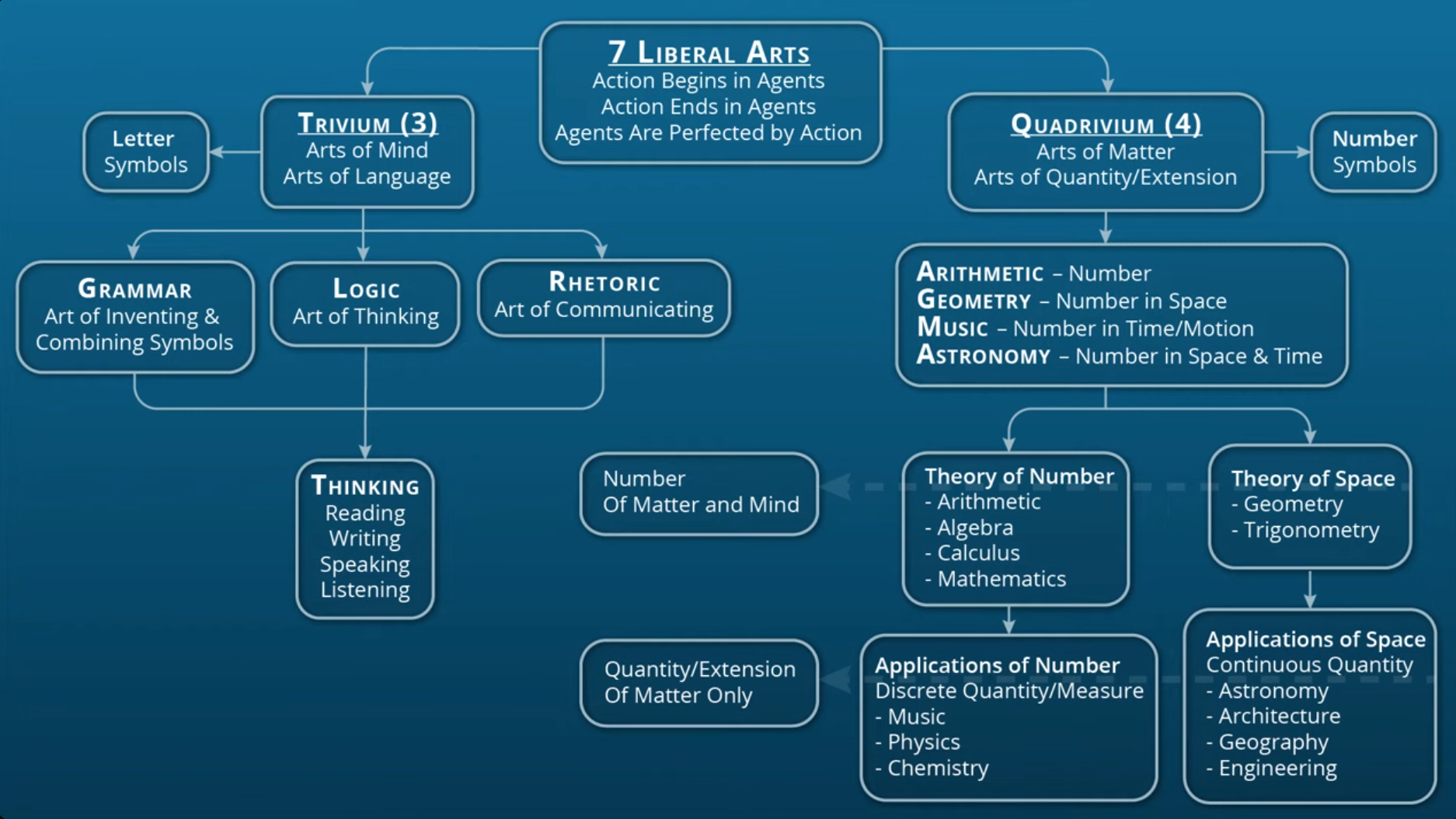
In the classical
tradition, the liberal arts were as i said, divided into two parts:
the Trivium and the Quadrivium.
The Trivium (grammar, logic, rhetoric) trained the mind in language and thinking, while the
Quadrivium (arithmetic, geometry, music, and astronomy) cultivated
mathematical and scientific understanding. The Trivium was always
taught first, because it laid the necessary foundation for abstract
thought and inquiry, the ability to learn and to think. The Trivium is not trivial though it is the origin of the word. The word trivial derives from the fact that the trivium contained the least complicated studies. Evidence that people didn't understand the concept i'm explaining here.
They are not trivial subjects in and of themselves, but the foundational structure which is then used for mastering not just the Quadrivium but the self. Then armed with a firm grasp of the liberal arts, higher more specialized degrees could be pursued.
In order to do so we must first study grammar, logic, and rhetoric mindful of the fact that we are doing so conceptually as well as concretely, in the same manner that the algebra can be used for base ten mathematics or any other base. It is generic math. The Trivium applies to the structuring of mind so that the mind can learn, employ logic and reasoning and express itself. That mind may inhabit a vessel that is "disabled and disadvantaged". Regardless: the methodology will work to free it.
Better yet if the vessel is "normal" and better yet if it is "gifted". (Gifted by whom?)
John Taylor Gatto Interviews
Rather than type long dissertations on the failings of the current education system due to their eschewing of the trivium i place these interviews for your convenience. Watch them at your leisure, share with educators & parents who genuinely want to make a difference.
AJ was how i first came across JTG, way back around 1999...25 years later not much has changed. Except it has gotten worse.
These videos are worth your time. Learn by negative example. The Trivium is the opposite of what he describes and a solution for homeschoolers and Montessorians...
These are no longer as radical as they were just ten years ago, it has entered into the consciousness and "suddenly" Homeschooling exploded.
If you don't have time to watch everything, immediately watch this one:
"The Neglected Genius of Western Spirituality"
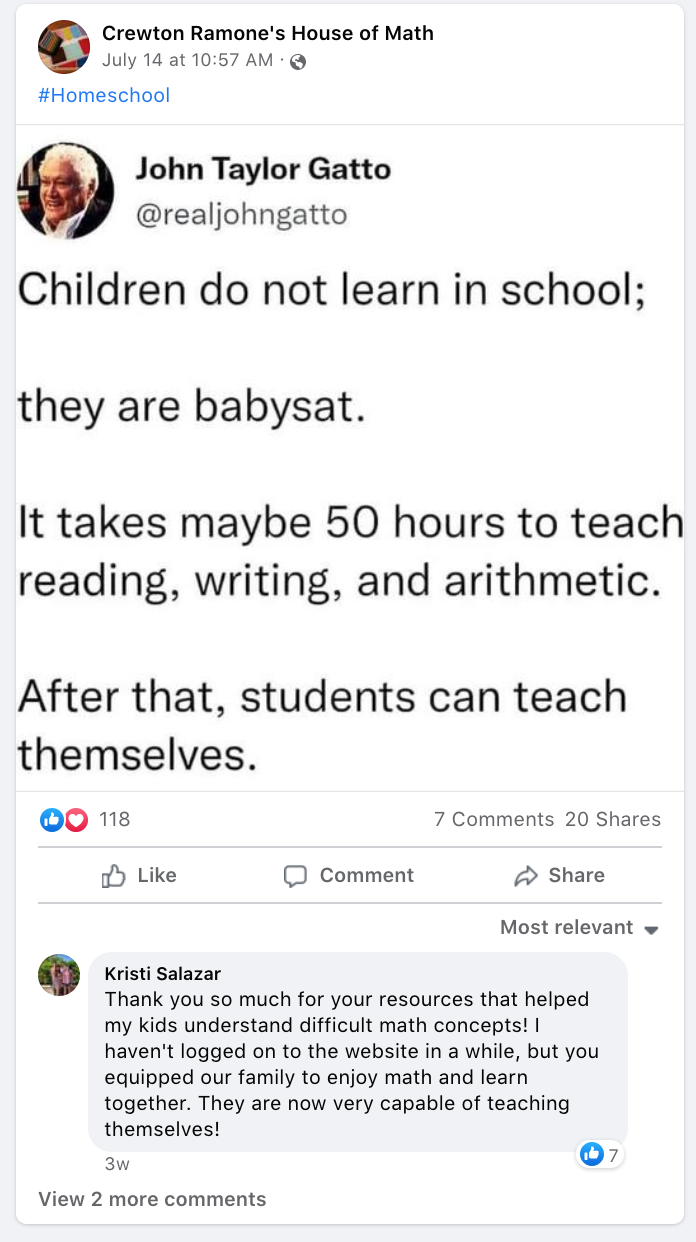
7 March 2009
"Examples of Educated People"
The Three Fold Path
Grammar: the structure and vocabulary of a language, the rules for comprehension. Grammar when used in this sense is more than the mechanics of a language; it is the art of understanding and correctly using symbols, especially the words or vocabulary of a given field, endeavor, or discipline. Grammar equips the learner with vocabulary and rules, enabling clarity and precision in thought. Grammar in mathematics is syntax. Grammar in "law" and statute is sometimes called legalese. Find out what the terms "includes" and "person" mean for example.
Logic (or dialectic): the science of reasoning, used to determine truth and falsity. Discernment. Logic (or dialectic) teaches reasoning. Students learn how to distinguish truth from falsehood, valid arguments from invalid arguments. It is the discipline of orderly thinking and analysis. Mathematical games and activities can be used to teach logic, as you will see on the logic page. Logic is required for the quadrivium all the sciences, and even the arts.
Rhetoric: the art of expressing ideas persuasively and beautifully. Rhetoric is the art of effective expression spoken or written, artistically or musically. It teaches students not only to persuade but to speak and write with beauty, force, and purpose. This is the origin of the drawer, and recorder, in the banker-builder-drawer-recorder model. Learn how to learn. Learn how to think, not what to think. They learn how to describe the world around them and express their place in it.

This is the sequence: first understanding and identifying symbols (grammar and
vocabulary), then organizing ideas (logic) facilitated by clever use
of the rectangle, then communicating this effectively (thru
rhetoric); in the mathematics this manifests as formulae &
theorem—it reflects the natural development of human cognition. The
Trivium in liberal arts serves not merely to impart content, but to
cultivate wisdom, it isn't a subject in and of itself but the three lane pathway or the road that takes the mind through knowledge and understanding.
In an age of fragmented and specialized knowledge,
it offers a cohesive approach to learning how to learn. Learning how
to think, not being programmed with what to think. It is used to explore and discover the world and the universe both visible and invisible, tangible and intangible.
If you want to be "Montessori Purests" implement The Trivium in your Montessori School mindfully..
The Trivium in Montessori Education
The
Mortensen Method is based on the Montessori method, founded by Dr.
Maria Montessori in the early 20th century, it may appear modern,
progressive, and "new" but it aligns closely with the classical vision
of education represented by the Trivium.
Montessori education
emphasizes natural developmental stages, hands-on learning, and the
cultivation of independence and responsibility. Though not framed
explicitly in terms of the Trivium, Montessori’s stages of
development mirror in its structure and reflect its influence. And these in turn reflect our knowledge of brainwave activity and the development of the brain from delta to gamma.
You may be familiar with this blog post, House For A Duck, it speaks about brainwave activity.
The
human brain moves through different dominant
brainwave frequencies
as it matures. These electrical patterns—delta, theta, alpha, beta,
and gamma—relate to states of consciousness, attention, and
learning. These stages line up remarkably well with the progression
of the Trivium.
The ages are approximations, i have seen ten
year olds that are not consistently making alpha waves, i've met
genius 7 year olds that are clearly making beta waves...but generally
speaking, statistically, bell curve speaking, these are the ages and
brain wave stages and corresponding trivium stage.
Brainwaves and the Trivium.
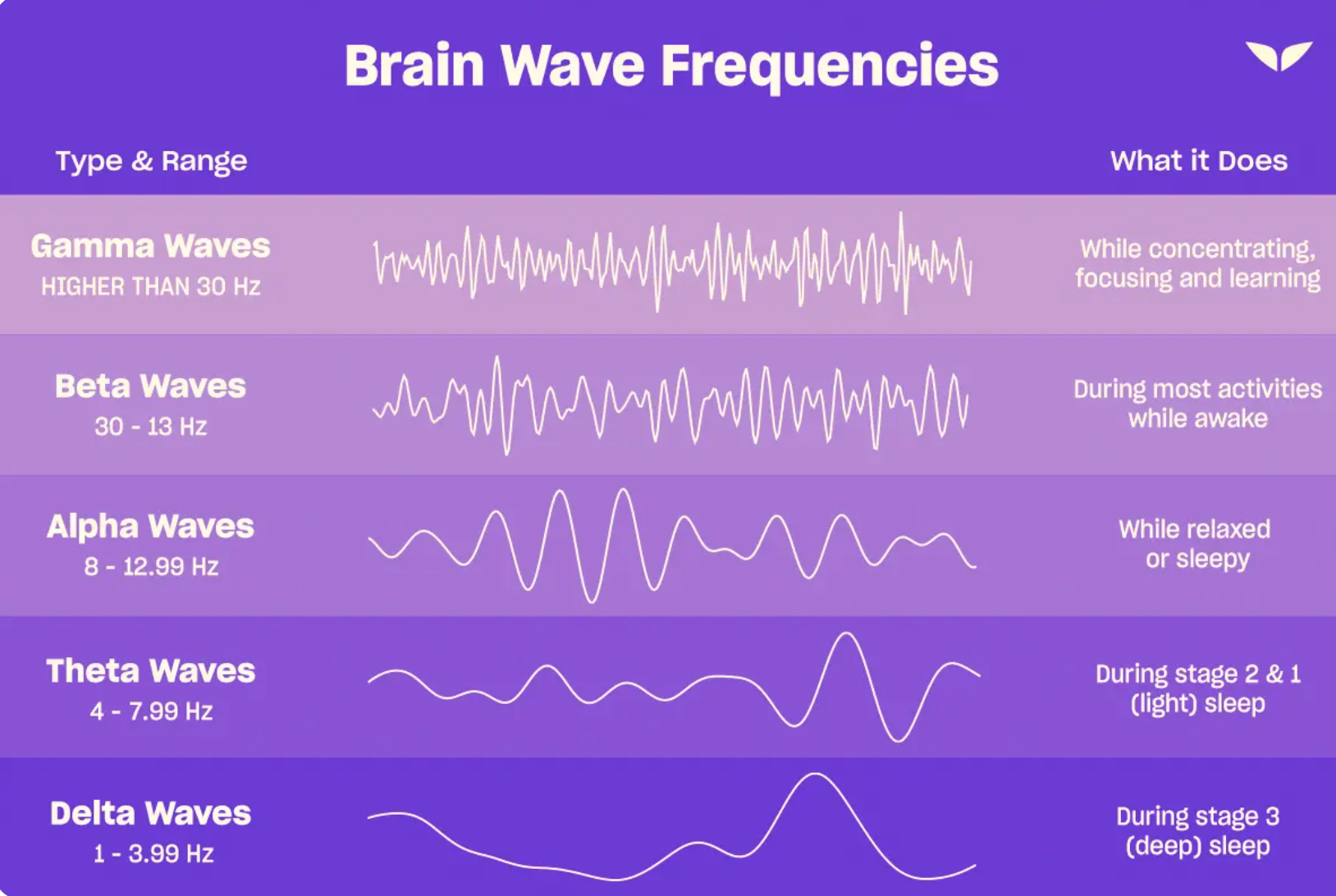
Delta Waves (Ages 0–2)
Frequency: 0.5–4 Hz
State:
Deep sleep and unconscious processing
Trivium Stage: Pre-Grammar
Explanation:
Babies are in a highly absorptive state with zero to minimal conscious
analysis.
This is pre-grammar but essential groundwork as
sensory and language circuits begin forming. Exposing children to Mandarin Chinese, for example, will enable them to hear certain tones that
others who were never exposed to these sounds simply will not be able
to hear when they get older.
Theta Waves (Ages 2–6)
Frequency: 4–8 Hz
State: Imaginative, emotional, hypnotic
Trivium Stage: Grammar
Explanation:
Children are in a sponge-like state, rapidly learning language,
absorbing patterns, and mimicking adult speech. This is the ideal
time to teach vocabulary, phonics, and symbolic recognition—including
mathematical symbols. Languages other than the mother tongue are easily learned.
This is an
extremely dangerous time to leave your child unattended in front of
devices using light and sound to program their subconscious minds.
The programming is happening beneath the conscious level. Be aware. There are those who would do your thinking for you.
This a great time to memorize multiplication tables, state and world capitals, geography, the presidents, the greek alphabet or any alphabet. Use the three period lesson to teach, and teach math like you would vocabulary. SIN means opposite over hypotenuse...you aren't doing math, you are learning what words mean.
Grammar
Stage (Ages 3–6):
In early childhood, Montessori students absorb
language effortlessly. Montessori calls this the “absorbent mind.”
This is the stage for vocabulary building, memorization, and
classification where children learn language, order, and
classification. This is the stage for not just memorizing but knowing
45 addends and 400 multiplication facts. They take in vocabulary,
social norms, and grammatical structures effortlessly. This is they
time to teach them Chinese characters and music. Children are
introduced to phonics, grammar symbols, and sentence
construction—concepts foundational to classical grammar.
Identifying numerals, operators, algebraic symbols, fractions, and
more often boil down to vocabulary when they are very young. This
is ½, hold up one half, no need for any more explanation. Same as
this is a spoon. If you want to know why: etymology. If you want to
know more about ½ study math. i even tell you what the line is
called between the one and the two. They even “forgot” to teach
you that. The fractions page at the house of math is now a course and
a resource.
Alpha Waves (Ages 7–12)
Frequency: 8–12 Hz
State: Calm alertness, logic, exploration
Trivium Stage: Logic
Explanation:
Children begin asking structured questions, testing cause-effect
relationships, and understanding abstract ideas. This is the natural
time for problem-solving, scientific method, and basic reasoning.
Logic
Stage (Ages 7–12):
As children mature, they develop reasoning
skills. Montessori students begin to ask “why” and explore cause
and effect. As reasoning emerges, children begin to ask “why,”
explore relationships, and test cause and effect. Montessori
materials now encourage problem-solving, independence, and
experimentation. They engage in hands-on “experiments”, puzzles,
and problem solving with mathematics using mathematics. Historical
analysis including biblical analysis can be scrutinized using logic
and reasoning with surprising results. The materials and the math
rich or learning rich environment should encourage curiosity
investigation, classification, understanding and discovering
patterns, recognizing those patterns = pattern recognition —echoing
the dialectical focus of logic. i show you lessons that help develop
pattern recognition. Lessons you will find nowhere else. Above all
the mathematics is predictive.
Teachers are there to direct
discovery. Once pupils know how to learn and how to think they can
explore and discover their math rich environment, teaching themselves becomes a natural and ongoing
endeavor. Montessorians are usually life-long learners. THEY decide what to think. They know how to learn and they decide what they want to learn.
“Each
plane of development must be approached with methods suitable to the
psychological characteristics of the children in that phase.
Otherwise, education becomes not only ineffective but harmful". ~Mario Montessori, The
Human Tendencies and Montessori Education
(1956)
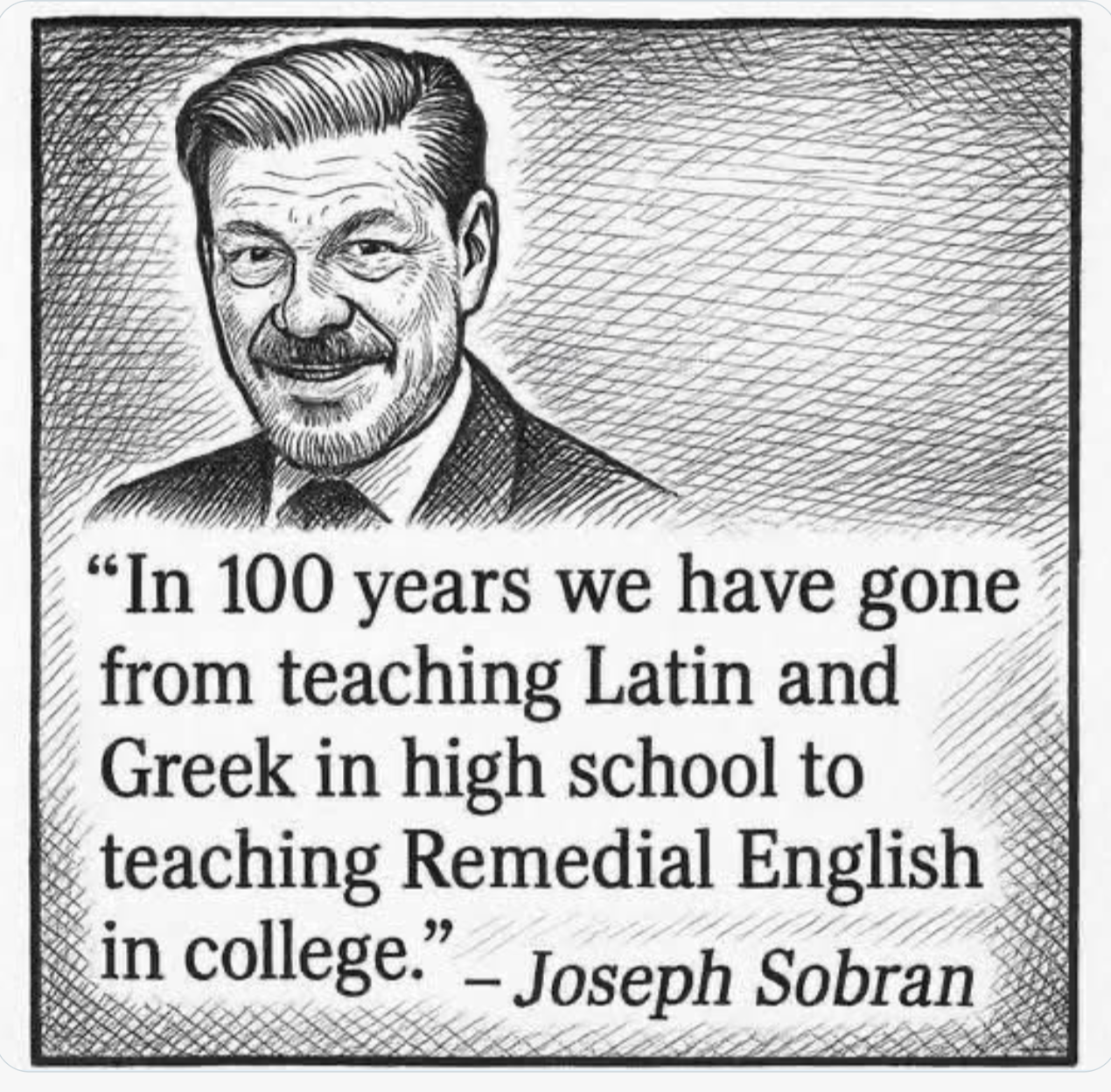
Beta Waves (Ages 12–18)
Frequency: 12–30 Hz
State: Focused attention, abstract thinking, planning
Trivium Stage: Rhetoric
Explanation:
Teens become capable of self-expression, debating, persuasive
writing, and self-reflection. They form identity and
worldview—rhetoric becomes the vehicle for expression, integration, and
influence.
Adolescents (12 – 21):
Adolescents become increasingly aware of their individuality and are
ready to express complex ideas. They develop personal opinions and
engage in real-world dialogue with peers, parents and teachers.
Montessori students develop abstract reasoning and their personal
voice. They present ideas, conduct debates, write essays, and engage
in collaborative problem-solving. These are the elements of
rhetoric—constructing and expressing complex ideas with clarity and
persuasion.
Montessori education thus harmonizes with the Trivium by honoring the developmental nature of learning. The teacher serves as a guide rather than a lecturer, one who directs their discovery in the math rich or learning rich environments as the case may be, allowing each child to internalize the tools of the Trivium in a personally meaningful way through the use of manipulatives played with in a purposeful way. The first purpose is to master five basic concepts while learning 45 addends and 400 multiplication facts so that computation is easy. Again: computation is not the mathematics, it's how we DO the mathematics.
Montessori’s
structure supports the idea that there is a time
and season
to teach each skill. Ecclesiastes 3. Pushing logic or rhetoric too
early is not only ineffective—it is developmentally inappropriate.
This insight aligns perfectly with both the Trivium and recent
discoveries in brain development. Conversely teaching mathematical
concepts too late can handicap the child's mathematical education
causing permanent damage. This damage can be reversed but it is
difficult and why not avoid it in the first place? For example the
longer you wait teach multiplication more difficult it becomes.
Gamma Waves (Adulthood and Beyond)
Frequency: 30–100 Hz
State: High-level cognition, synthesis
Explanation:
The brain, not to be confused with the mind, but the organ itself, doesn't fully mature until about the age of 28 depending on the study cited. Adults use all stages of the Trivium fluidly. Grammar, logic, and
rhetoric are combined to create, teach, innovate, and lead.
This alignment
shows that education is most effective when it flows with the brain’s
natural development, not against it. Understanding brainwaves allows
educators to time instruction wisely, respecting both the pace and
nature of growing minds. Most people wait too long to begin instruction especially if that instruction involves rote memorization.
The Trivium and Mathematics
Mathematics may
seem distant from grammar and rhetoric, but within the structure of
the Trivium, it finds an elegant parallel. Classical educators
recognized that the Trivium taught the language of thinking, which is
essential for all disciplines. Mathematics is the language of
thinking. It is the language that describes the universe we live in
most precisely. It is the language that describes the mind. Mind is
the first hermetic principle. The five basic concepts apply to all
three here.
Mathematical
Grammar
refers to learning symbols, definitions, and operations. This
includes numerals, functions, equations, and axioms. Just as a
language student must know the parts of speech, a math student must
learn symbols and syntax.
Mathematical
Grammar = Syntax. Syntax
is the set of formal
rules
that govern how symbols and expressions are structured in
mathematics. Just as grammatical syntax governs how words form
sentences, mathematical syntax ensures that symbols follow
meaningful, valid patterns (e.g., 3 + 2 = 5 is valid syntax; x+ 1 =
x is not). In learning math, understanding syntax
is foundational—disobeying PEMDAS, undefined terms, unlabeled axises,
or inconsistent or absent notation can all lead to confusion.
Mathematical Logic teaches the process of reasoning through problem solving. Students learn to use deductive and inductive reasoning, construct proofs, and understand abstract relationships. It is the dialectical stage of mathematical thinking. Once students learn symbolic structure, they begin applying reasoning: solving equations, creating proofs, and testing the validity of arguments. This stage involves cause and effect, induction and deduction, and systems thinking. Deductive reasoning is developed through creative use of story problems in the Mortensen Math Series A Manuals.
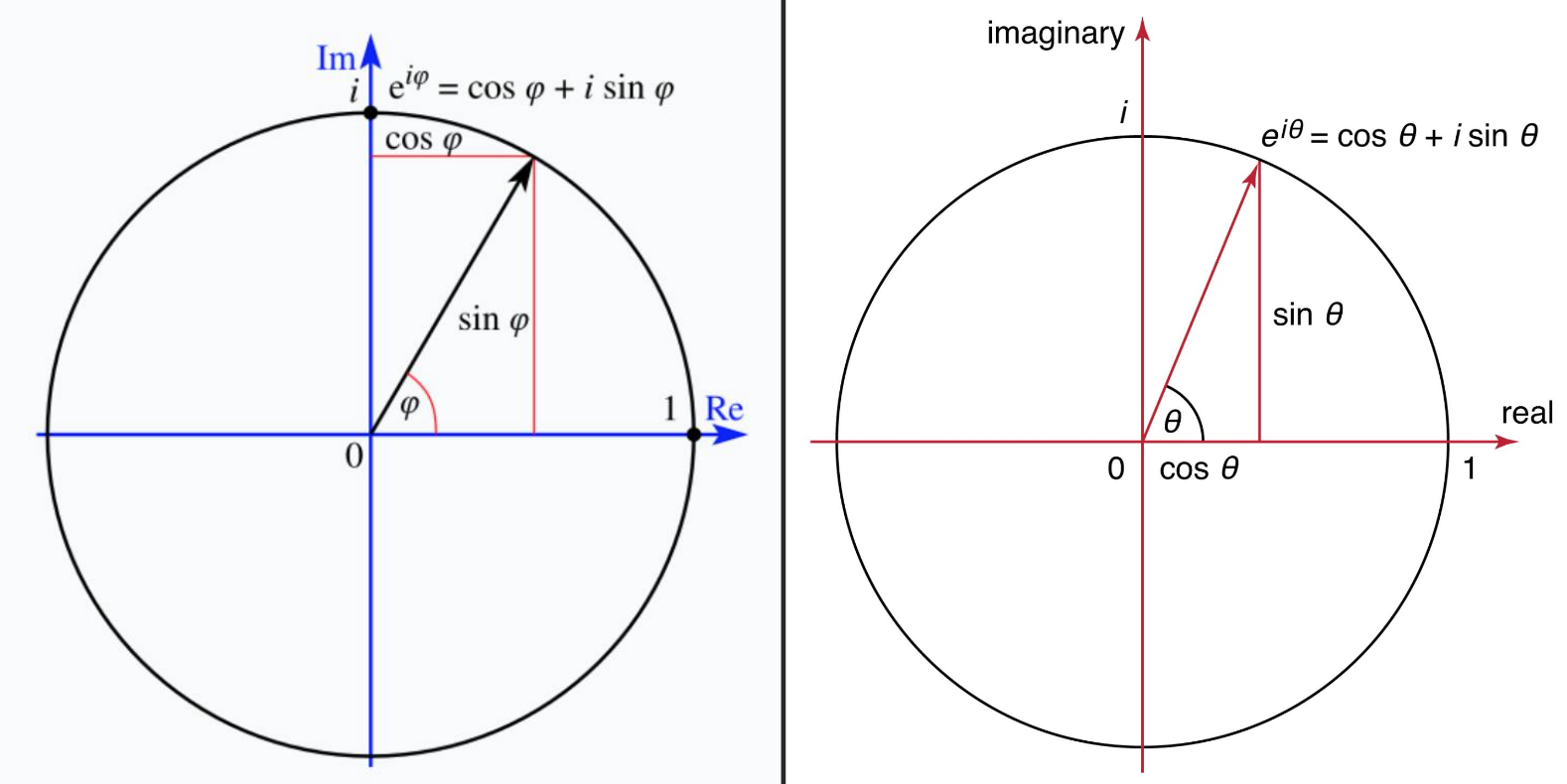 Slightly different symbols same exact concept. Mathematical Rhetoric. Euler expresses his genius concisely.
Slightly different symbols same exact concept. Mathematical Rhetoric. Euler expresses his genius concisely.Mathematical
Rhetoric
involves communicating mathematical ideas clearly and effectively.
This includes theorems, constructing written proofs, explaining problem-solving
steps, and even using graphs or models to persuade others of a
conclusion. The “art” of math becomes apparent in elegant proofs
or efficient algorithms & deceptively simple theorems, where beauty and clarity converge.
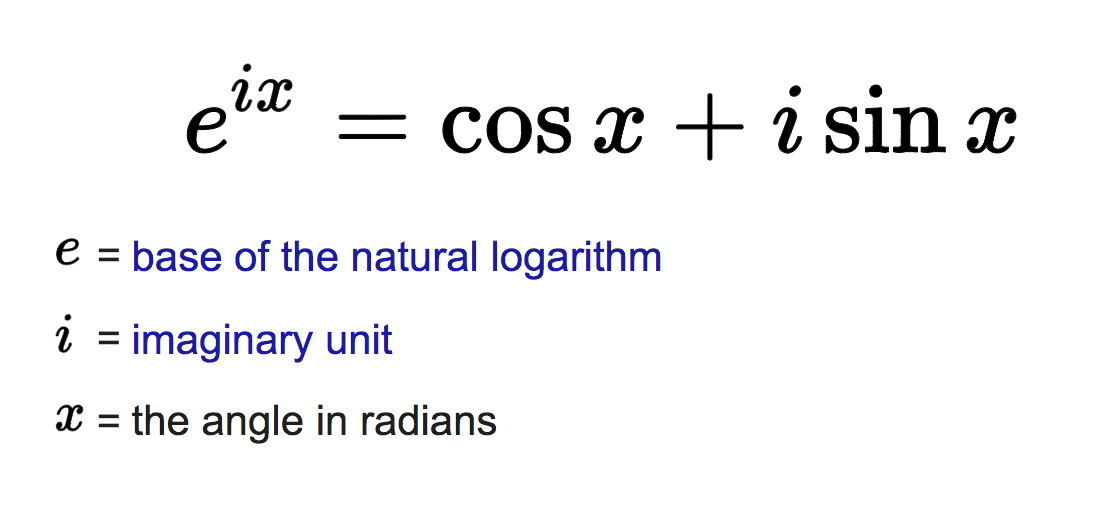
a² + b² = c²
In
advanced stages, math becomes a language of ideas. Mathematicians
must present proofs clearly, write mathematically coherent essays,
and explain abstract theories with precision. Whether through written
proofs, modeling, or presentations, rhetorical skills in math help
express insight and convince others of truth.
Though math is traditionally grouped under the Quadrivium, it too rests on Trivium principles. Mathematics has its own forms of grammar, logic, and rhetoric:
In an age obsessed with early achievement, the Trivium reminds us: there is a season for everything. Teaching logic to toddlers or even trying to reason with them when their brains are quite literally incapable of consistently making the brainwaves required or pushing rhetorical performance on unready adolescents may yield stress and confusion, not wisdom. Brain development, Montessori practice, and classical education all affirm that timing matters.
The Trivium offers not only a method of instruction but also a philosophy of respect for the learner. It honors the progression of understanding—from naming things, to knowing them, to communicating truth beautifully and usefully.
In the mathematics the Trivium offers the scaffold for moving from symbol recognition (syntax) to problem-solving (logic) to expression or formulae (rhetoric), for example a² + b² = c².
 Degree of difficulty and the Trivium three fold path. Place the child in a math rich environment. Put them in a situation where they can not fail. Direct their discovery. Expect success.
Degree of difficulty and the Trivium three fold path. Place the child in a math rich environment. Put them in a situation where they can not fail. Direct their discovery. Expect success.Some classical
educators might say that the Quadrivium is built upon the
Trivium—that the study of mathematics is only possible once one
knows how to think and communicate well. They also think this is reflected or expressed by the child's ability to work a pencil. This line of thinking is
often carried over into the structured teaching of mathematics and
the incorrect application of scaffolding wherein mathematical
concepts and subjects are treated as separate things instead of ONE
cohesive thing described by five basic concepts. This leads to months
spent on place value, then addition, then subtraction, then
multiplication usually with endless worksheets, then division, then fractions, then decimals, then
algebra, then geometry, then more allegedly advanced algebra, then pre-calculus, then
calculus...and as Jerry said by then it has all become a meaningless
dance, rules and process: no understanding. Memorizing the unit
circle with no understanding of the triangles we are supposed to be
studying as one example. Write one two three, three two one square root the tops divide everybody by two.
ZERO Understanding
If you would actually like to understand what you are doing and SEE the triangles involved go here. (link not built yet)
Mathematics is not separate from the
liberal arts but is an extension of them. In the modern classroom or
homeschool, integrating Trivium methods into mathematics
instruction—such as teaching students to express mathematical
reasoning using writing, using drawings, using pictures, with notes
that are in English not just mathematical symbols—helps dissolve
artificial boundaries created between disciplines. Common core
attempted to do this poorly. So poorly it couldn't just be an
accident or incompetence. John Taylor Gatto and Charlotte Thomson
Iserbyt informed us that none of this radical departure from tried
and true ancient methodology was an accident but by design.
Teen
agers who i tutor often hear me admonish them to put English in
their notes. Write instructions on how to do the problems and why to
themselves. Get extra clever and think about which of the five
concepts apply.
Contemporary and Continuing Relevance of the Trivium
The
Trivium and Vertical Alignment in Montessori Education
Vertical Alignment refers to the deliberate sequencing of curriculum and skills from one educational level to the next, ensuring coherence and continuity across grades levels or advancing tiers. When viewed through the lens of the Trivium—grammar, logic, and rhetoric—vertical alignment becomes not just a tool for academic consistency, but a framework for developmentally appropriate pedagogy that mirrors the natural growth of the human mind as evidenced by modern brainwave technology.
In the grammar stage, typically aligned with early childhood and lower elementary grades, vertical alignment emphasizes symbol recognition, vocabulary acquisition, and concrete experiences. Here, students learn foundational knowledge: letters, numbers, phonics, vocabulary, math facts, and basic scientific observations. Vertical alignment ensures that this stage fully prepares students for abstract reasoning at a later date.
In the logic stage, corresponding to upper elementary and middle school years, students begin to analyze, compare, and question. A vertically aligned curriculum at this level connects earlier facts to underlying structures, such as grammar rules, mathematical reasoning, or cause-effect relationships in history, chemistry, and physics. Instruction now focuses on pattern recognition, logical connections between disparate events, critical thinking and reasoning. These skills are learned not inherited and can be taught.
The rhetoric stage, typically seen in high school and beyond, develops students’ ability to express integrated knowledge with clarity, creativity, and persuasion. Vertical alignment ensures that students have mastered foundational skills and reasoning before they are asked to synthesize and present complex ideas.
Thus, the Trivium provides a timeless, effective, versatile, blueprint confirmed by modern science, for a vertically aligned education: a journey from memorization and process, to knowing, to understanding well enough to exhibit mastery and explain basic concepts to others.
In today’s educational landscape, the Trivium offers a counterbalance to rote memorization, fragmented testing, passive learning, memorizing rules and process or formulas with no idea how to derive them or memorizing rules with no idea why the rule was made or why it exists. For example why do we invert and multiply when dividing fractions? The Trivium advocates for a sequence of understanding: first absorbing facts and symbols (grammar), then analyzing relationships (logic), then producing original, persuasive output (rhetoric). Whether one is writing a poem, solving a math problem, or debating ethics, the Trivium cultivates the internal tools of intellectual freedom. The Temple of Math and Crewton Ramone's House of Math are staunch proponents of the liberal arts and . . therefore the Trivium.
Moreover, the
Trivium provides a unifying framework foundation for all liberal arts
subjects. In an interdisciplinary world, where STEM and the
humanities often compete, the Trivium bridges the divide. It shows
that logic and reasoning are not exclusive to the mathematics,
sciences or philosophy—critical thinking, logic and reasoning, in
fact, underpin all meaningful thought expressed through language
(rhetoric) and are the foundation of the Quadrivium, besides: math IS
language, the language this creation is written in. If one wishes to
know the secrets of the universe, one must know mathematics.
The Trivium and the Biology of Belief
The
Trivium’s stages—grammar (absorb), logic (analyze), and rhetoric
(articulate)—align not only with cognitive development and brain
wave development, but also with how belief systems are formed and
reinforced, as explained by Bruce Lipton in the ground breaking work,
“The Biology of Belief”. Lipton, a cell biologist, and stem cell
researcher dating back to the 1960's, argues that our
perceptions—especially in early life—shape gene expression and
brain development through epigenetics. Beliefs, once formed,
influence our biology. Lipton is a pioneer in the fascinating science
of epigenitics.
In the grammar stage, children unconsciously absorb
information and emotional tone from their environment. They are in
download mode. These impressions become the foundation of
subconscious belief systems. Maria called this the absorbent mind.

The logic stage
enables children to question and evaluate those early inputs,
potentially reshaping limiting beliefs. Psych-K a method for
discovering and rapidly changing beliefs that are not serving you or
yours and can help with this reprogramming. Also the work of Tony
Robbins and others can help the child to identify and change limiting
beliefs.
Finally, the rhetoric stage allows us to consciously
express, embody, and act on integrated, empowered beliefs. However,
the same is true with negative disempowering beliefs that the child
(or adult) may not even know are there. Logic and reasoning leads to
increased self awareness when the analysis is turned inward in a
healthy beneficial manner.
Audio book: The Biology of Belief
Thus, the Trivium reflects the
neuro-linguistic pathway through which beliefs are absorbed both
consciously and unconsciously in the grammar stage, examined in the
logic stage, and expressed in the rhetoric stage. Bruce Lipton’s
insights align with the Trivium., The Trivium becomes a powerful
framework for understanding and reprogramming limiting patterns and
cultivating self-directed growth—where learning isn’t just about
acquiring knowledge, but about consciously shaping the mind, body,
and future through grammar, logic and reason, and through rhetoric
that can express both “positive and negative” beliefs. There is
no such thing as a negative belief, technically, but there are
beliefs that do not serve the believer.
The Trivium remains an enduring model for how we teach and learn. It forms the intellectual scaffolding for liberal arts education, aligns naturally with the Montessori method, and enriches the study of mathematics. More than a curriculum, the Trivium is a philosophy of learning that trains not just the memory or the intellect, but the whole mind. It is not the meeting of three paths but one three fold path. In a world saturated with information but short on wisdom, the Trivium invites us to return to the roots of learning: to develop discernment, to understand clearly, reason soundly, and speak truthfully.
The Montessori Method. 11 Hours.
Supporting works:
Download PDF with clickable links to PDF and online versions of Maria's Works HERE.
Maria Montessori,
Education
and Peace,
trans. Helen Lane (Oxford: Clio Press, 1949),
Maria Montessori, The Absorbent Mind, trans. Claude A. Claremont (Madras: Kalakshetra Press, 1949), esp. chapters 3, 6, and 19.
Mario Montessori, The Human Tendencies and Montessori Education (Amsterdam: AMI Publications, 1956),
Maria Montessori, The Discovery of the Child, trans. Mary A. Johnstone (Madras: Kalakshetra Press, 1948),
Maria Montessori,
The Secret of Childhood (New York: Ballantine Books, 1966),
John Taylor
Gatto:The Underground History of American Education: An Intimate
Investigation Into the Prison of Modern Schooling (New Society
Publishers, 1999)
John Taylor
Gatto: Dumbing US Down: The Hidden Curriculum of Compulsory
Schooling (New Society
Publishers, 2001)
Charlotte Thomson
Iserbyt The Deliberate Dumbing Down of America: A Chronological Paper
Trail (Conscience Press 1999)
Bruce H. Lipton, The Biology of Belief: Unleashing the Power of Consciousness, Matter, & Miracles (Hay House Inc. 2008)
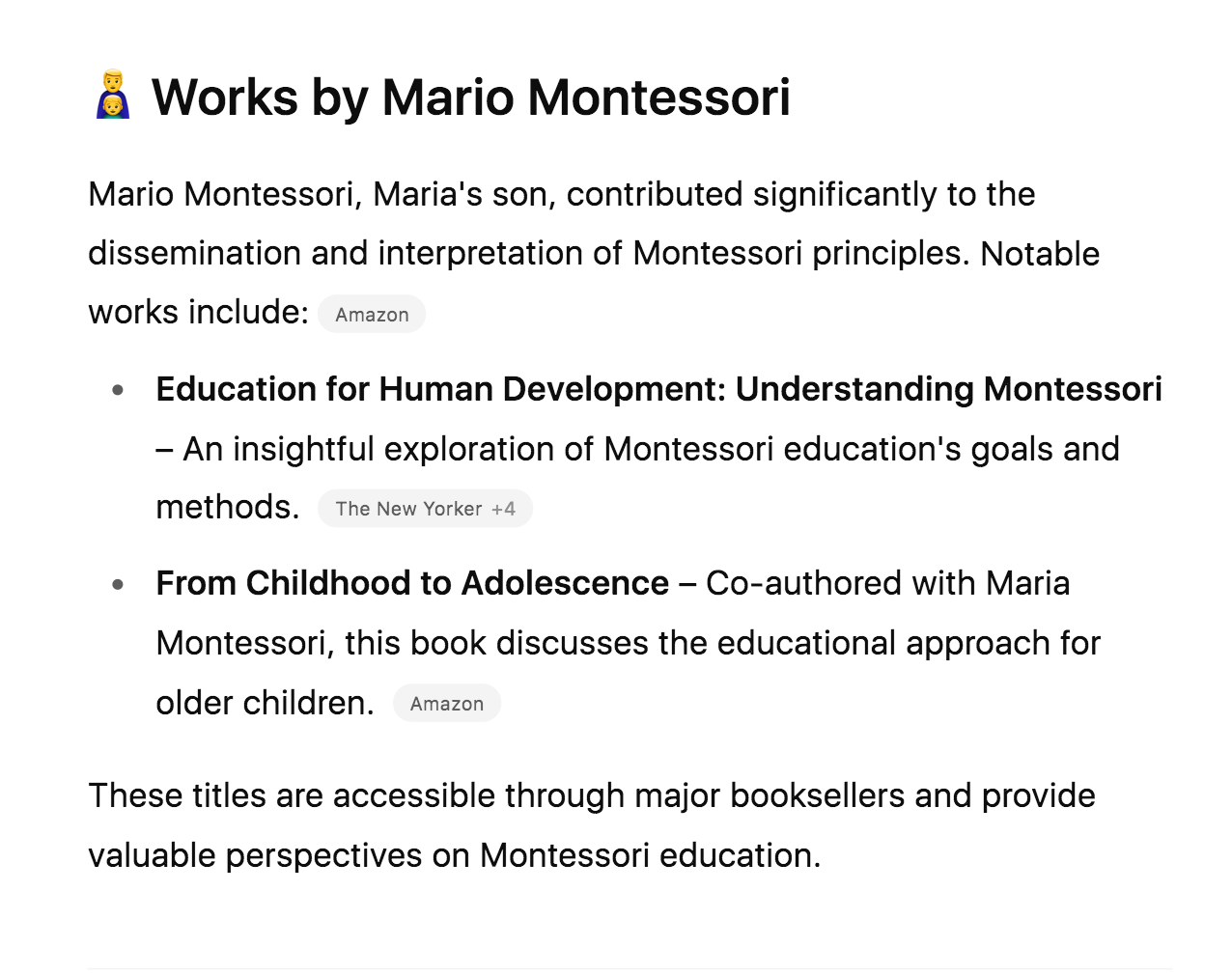
War or education.
This may actually be more relevant now than it was then; we have now the vantage of hindsight. We were warned. i chose this video because the original upload is so old it is from back when videos could only be 15 minutes long; remember that? This is one continuous presentation. On this topic as with may others AJ was well ahead of his time.
"We are in a race between education and catastrophe".
Suddenly, people are rediscovering her. Rather than read or listen to what others have to say about her, why not listen to her directly and form your own opinion?
Glossary 23 terms:
- Absorbent Mind: A term used by Maria Montessori to describe the young child's ability to absorb knowledge and experiences from their environment.
- Alpha Waves: Brainwaves associated with calm alertness and logical thinking (ages 7-12).
- Beta Waves: Brainwaves associated with focused attention and abstract thinking (ages 12-18).
- Biology of Belief: A concept developed by Bruce Lipton, suggesting that our perceptions and beliefs shape our biology and influence our development.
- Brainwave Stages: Different frequencies of brain activity associated with various stages of cognitive development, including delta, theta, alpha, beta, and gamma waves.
- Delta Waves: Brainwaves associated with deep sleep and unconscious processing (ages 0-2).
- Epigenetics: The study of how environmental factors influence gene expression and development.
- Five Basic Concepts: A framework for understanding mathematical concepts, emphasizing the interconnectedness of mathematical ideas and relationships.
- Gamma Waves: Brainwaves associated with high-level cognition and synthesis (adulthood).
- Grammar Stage: The foundational stage of learning, focusing on symbol recognition, vocabulary acquisition, and concrete experiences (ages 3-6).
- Liberal Arts: A broad range of academic subjects, including language, mathematics, science, and philosophy, aimed at cultivating critical thinking and intellectual freedom.
- Logic Stage: The stage of learning that emphasizes reasoning, analysis, and problem-solving (ages 7-12).
- Math Rich Environment: A learning environment that is filled with mathematical materials, manipulatives, and opportunities for exploration and discovery, designed to foster a deep understanding of mathematical concepts and relationships.
- Mathematical Grammar: The study of mathematical symbols, definitions, and operations.
- Mathematical Logic: The study of mathematical reasoning, problem-solving, and proof construction.
- Mathematical Rhetoric: The art of communicating mathematical ideas clearly and effectively.
- Montessori Method: An educational approach developed by Maria Montessori, emphasizing self-directed learning, hands-on activities, and mixed-age classrooms.
- Pedagogy: The art, science, or profession of teaching, including the methods, techniques, and philosophies used in educational settings.
- Quadrivium: A set of four liberal arts subjects (arithmetic, geometry, music, and astronomy) that build upon the Trivium.
- Rhetoric Stage: The stage of learning that focuses on effective expression, persuasion, and communication (ages 12-18).
- Theta Waves: Brainwaves associated with imagination, creativity, and learning (ages 2-6).
- Trivium: A classical liberal arts education framework consisting of grammar, logic, and rhetoric stages.
- Vertical Alignment: The deliberate sequencing of curriculum and skills from one educational level to the next, ensuring coherence and continuity across grades or advancing tiers, and mirroring the natural growth of the human mind.
Another Aspect of The Trivium
“When you take the free will out of education, that turns it into schooling.”
― John Taylor Gatto
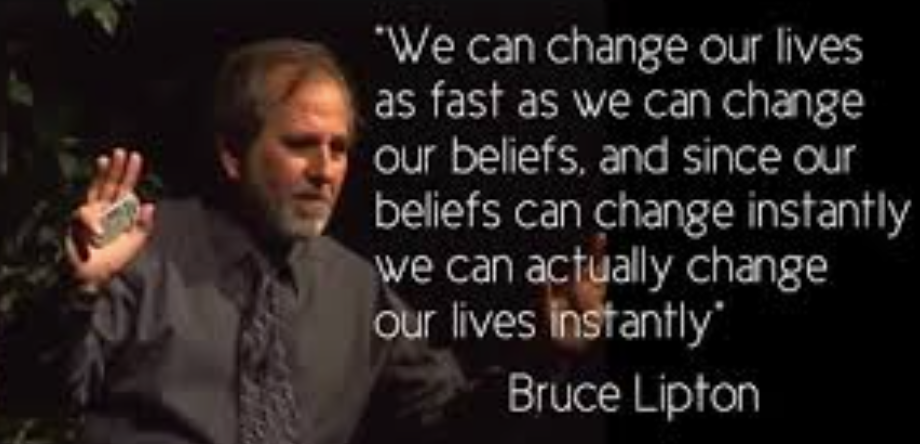
“What's gotten in the way of education in the United States is a theory of social engineering that says there is ONE RIGHT WAY to proceed with growing up.”
― John Taylor Gatto,
“Genius is an exceedingly common human quality, probably natural to most of us.”
― John Taylor Gatto
“Self-knowledge is the only basis of true knowledge.”
― John Taylor Gatto
“...good things happen to the human spirit when it is left alone.”
― John Taylor Gatto

“Of all things love is the most potent.”
~ Maria Montessori
“Imagination does not become great until human beings, given the courage and the strength, use it to create.”
― Maria Montessori
"Imagination is more important than knowledge OR information" ~ Some guy named "one stone".
“Never help a child with a task at which he feels he can succeed.”
― Maria Montessori
“The greatest sign of success for a teacher is to be able to say, "The children are now working as if I did not exist.”
~Maria Montessori
“Establishing lasting peace is the work of education; all politics can do is keep us out of war.”
~ Maria Montessori
tags: peace
“Within the child lies the fate of the future.”
~ Maria Montessori
“No social problem is as universal as the oppression of the child”
~Maria Montessori
More Quotes.

GRAMMAR
LOGIC
RHETORIC
Back to Liberal Arts
Want to see more free pages & lessons & other free stuff on this site?
Consider a dollar a month.
For $1 per month (the lowest level subscription) you get access to
The
Super Duper Super Secret Facebook Page.
You'll find hours and hours of videos with base ten blocks and information you won't find anywhere else not even on this website there. i often post video tutoring sessions there. Other people post vids and links there too. Lessons cost the people doing them minimum $60.00 and hour. You can watch 2 to 10 of them a month for a dollar...Do the math. Currently 127 people are there. About half of them are active.
You basically get a support group for a buck a month.
Here's My Patreon:
https://www.patreon.com/CrewtonRamone
Note: from time to time the passwords change. Simply e-mail me for a new one or a new passport as the case may be. Annual passes are good for one year, lifetime passes are good for as long as the site remains up, (site has been up for eight years now). All single page passwords have lifetime renewal.
🏫 "Let The Child Be The Guide"
Full Documentary
Note: Mortensen Product Ordering Buttons Have Been Removed Due To Shipping/Inventory Issues. i basically DO NOT sell product for them anymore. Use eBay or other sources for base ten blocks. Check with Anna's Math Page.
Want to see more free pages & lessons & other free stuff on this site?
Consider a dollar a month.
For $1 per month (the lowest level subscription) you get access to
The
Super Duper Super Secret Facebook Page.
You'll find hours and hours of videos with base ten blocks and information you won't find anywhere else not even on this website there. i often post video tutoring sessions there. Other people post vids and links there too. Lessons cost the people doing them minimum $60.00 and hour. You can watch 2 to 10 of them a month for a dollar...Do the math. Currently 127 people are there. About half of them are active.
You basically get a support group for a buck a month.
Here's My Patreon:
https://www.patreon.com/CrewtonRamone
Passwords have changed as of July2023.
The superduper supersecret math page on Facebook is NOT FREE. Just sign up for a buck a month or buy books or a password.
People are shocked and amazed when they see how much they get for a password. $43.33 goes a long way at the house of math.

